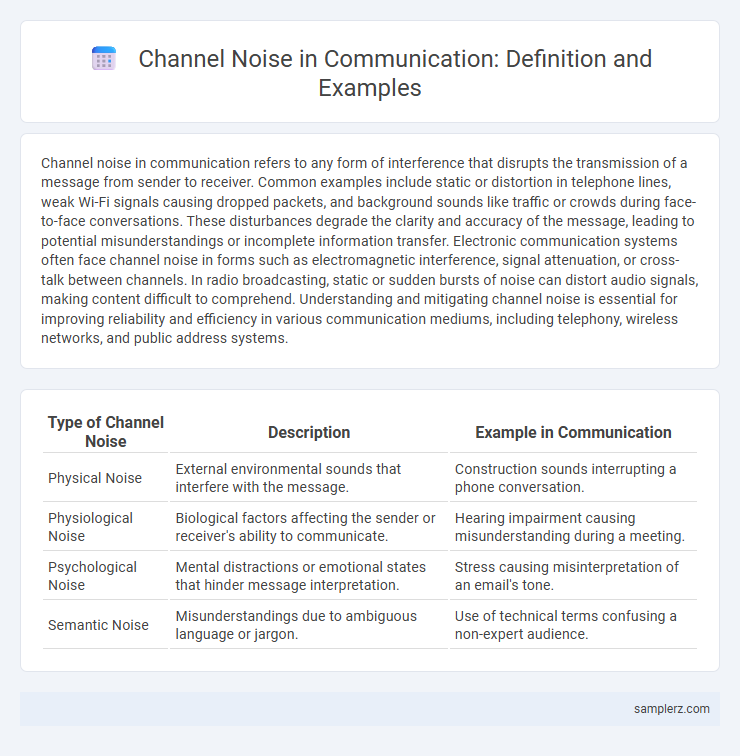Channel noise in communication refers to any form of interference that disrupts the transmission of a message from sender to receiver. Common examples include static or distortion in telephone lines, weak Wi-Fi signals causing dropped packets, and background sounds like traffic or crowds during face-to-face conversations. These disturbances degrade the clarity and accuracy of the message, leading to potential misunderstandings or incomplete information transfer. Electronic communication systems often face channel noise in forms such as electromagnetic interference, signal attenuation, or cross-talk between channels. In radio broadcasting, static or sudden bursts of noise can distort audio signals, making content difficult to comprehend. Understanding and mitigating channel noise is essential for improving reliability and efficiency in various communication mediums, including telephony, wireless networks, and public address systems.
Table of Comparison
| Type of Channel Noise | Description | Example in Communication |
|---|---|---|
| Physical Noise | External environmental sounds that interfere with the message. | Construction sounds interrupting a phone conversation. |
| Physiological Noise | Biological factors affecting the sender or receiver's ability to communicate. | Hearing impairment causing misunderstanding during a meeting. |
| Psychological Noise | Mental distractions or emotional states that hinder message interpretation. | Stress causing misinterpretation of an email's tone. |
| Semantic Noise | Misunderstandings due to ambiguous language or jargon. | Use of technical terms confusing a non-expert audience. |
Understanding Channel Noise in Communication
Channel noise in communication refers to any interference that distorts or interrupts the transmission of a message between the sender and receiver. Common examples include static in radio signals, background conversations in face-to-face communication, and digital glitches in wireless networks. Recognizing these disturbances is essential for improving message clarity and ensuring effective information exchange.
Common Examples of Channel Noise
Common examples of channel noise in communication include static on phone lines, poor internet connectivity causing dropped video calls, and background sounds interfering during face-to-face conversations. Electrical interference from nearby devices and signal attenuation over long distances also degrade message clarity. These types of channel noise disrupt the accurate transmission of information between sender and receiver.
Physical Noise: Barriers and Disturbances
Physical noise in communication includes environmental sounds such as construction noise, traffic, or loud machinery that interfere with message transmission. Barriers like poor lighting, physical obstructions, or malfunctioning communication devices also disrupt signal clarity. These disturbances reduce message accuracy and increase misunderstandings during face-to-face or digital interactions.
Technical Noise: Signal Interference
Technical noise in communication occurs when signal interference disrupts the clarity and accuracy of transmitted messages, such as electromagnetic interference from nearby electronic devices or radio frequency overlapping in wireless transmissions. This type of noise can degrade audio, video, or data signals, leading to misunderstandings or loss of critical information in digital and analog communication systems. Effective measures to minimize technical noise include using shielded cables, frequency hopping, and advanced error-correction protocols to maintain signal integrity.
Semantic Noise: Misinterpretation of Messages
Semantic noise occurs when the sender's intended meaning is misunderstood due to ambiguous language, cultural differences, or jargon unfamiliar to the receiver. For example, technical terms used by a specialist may confuse a layperson, leading to misinterpretation of the message. This type of noise disrupts effective communication by distorting the intended semantic content between parties.
Psychological Noise: Personal Biases and Emotions
Psychological noise in communication occurs when personal biases and emotions distort the sender's or receiver's message interpretation, hindering effective understanding. For example, a listener's preconceived negative opinions about the speaker can create selective perception, causing them to misinterpret or ignore the intended message. Emotions such as anger or anxiety also interfere with cognitive processing, leading to communication breakdowns in interpersonal interactions.
Environmental Noise: External Distractions
Environmental noise in communication refers to external distractions such as traffic sounds, construction activities, or loud conversations that interfere with the clarity of the message being transmitted. These auditory disruptions can cause misinterpretations, forcing the receiver to exert more effort to understand the sender's intent. Effective communication strategies must account for and minimize environmental noise to ensure accurate information exchange.
Channel Noise in Digital Communication
Channel noise in digital communication includes electromagnetic interference (EMI) from nearby electronic devices that distort signal transmission. Thermal noise caused by the random motion of electrons in cables generates errors in data reception. Signal attenuation and crosstalk further degrade the digital signal, reducing communication reliability and data integrity.
Impact of Channel Noise on Effective Communication
Channel noise, such as static on a telephone line or background noise during a conversation, significantly impairs message clarity and listener comprehension. This interference causes misunderstandings, delays in response, and information loss, disrupting the communication flow. Effective communication requires minimizing channel noise to ensure accurate transmission and reception of information.
Strategies to Minimize Channel Noise
Channel noise in communication includes static in telephone lines, signal interference in wireless networks, and background noise during face-to-face conversations. Strategies to minimize channel noise involve using noise-cancelling technology, enhancing signal clarity through error-correction protocols, and conducting communication in controlled environments with minimal external disturbances. Implementing these techniques improves message accuracy and reduces misunderstandings in various communication settings.

example of channel noise in communication Infographic
 samplerz.com
samplerz.com